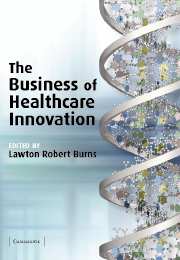Book contents
- Frontmatter
- Contents
- List of figures
- List of contributors
- Preface
- Acknowledgments
- 1 The business of healthcare innovation in the Wharton School curriculum
- Part I The life sciences
- Part II Devices and information technologies
- 6 The medical device sector
- 7 The healthcare information technology sector
- 8 Healthcare innovation across sectors: convergences and divergences
- Index
6 - The medical device sector
Published online by Cambridge University Press: 22 September 2009
- Frontmatter
- Contents
- List of figures
- List of contributors
- Preface
- Acknowledgments
- 1 The business of healthcare innovation in the Wharton School curriculum
- Part I The life sciences
- Part II Devices and information technologies
- 6 The medical device sector
- 7 The healthcare information technology sector
- 8 Healthcare innovation across sectors: convergences and divergences
- Index
Summary
Introduction
The medical device sector is by any measure one of the most attractive and profitable in all of American commerce. The broad set of products encompassed by this category span all physician specialties, touch every conceivable anatomy, and are applied to nearly every medical procedure. They range from the simplest surgical staples and sutures to complex electronic implantable devices that monitor and stimulate the heart. A cottage industry decades ago, it has consistently grown at mid-to-high single digit rates to reach over $165 billion in worldwide revenues in 2003. This total is divided between medical devices, accounting for approximately $90 billion in revenues, and commodity supplies at $75 billion.
While there are thousands of small specialized suppliers, the field is increasingly dominated by a dozen diversified franchise companies, each with extensive marketing, selling, and distribution capabilities and multiple billions of dollars in annual revenues. Three characteristics distinguish this vibrant sector: sustainable growth, high profitability, and rapid change. These and a handful of other attributes make the medical device sector unique – different from nearly all other commercial pursuits. This chapter will elaborate on these features and also on the important role that this sector has had and continues to have on the delivery of healthcare around the world. The discussion will focus on those segments within the medical products field that are the most technology-laden and have higher rates of growth, such as interventional cardiology products and implanted devices – pacemakers, defibrillators, and hip and knee replacements.
- Type
- Chapter
- Information
- The Business of Healthcare Innovation , pp. 271 - 321Publisher: Cambridge University PressPrint publication year: 2005
- 7
- Cited by



